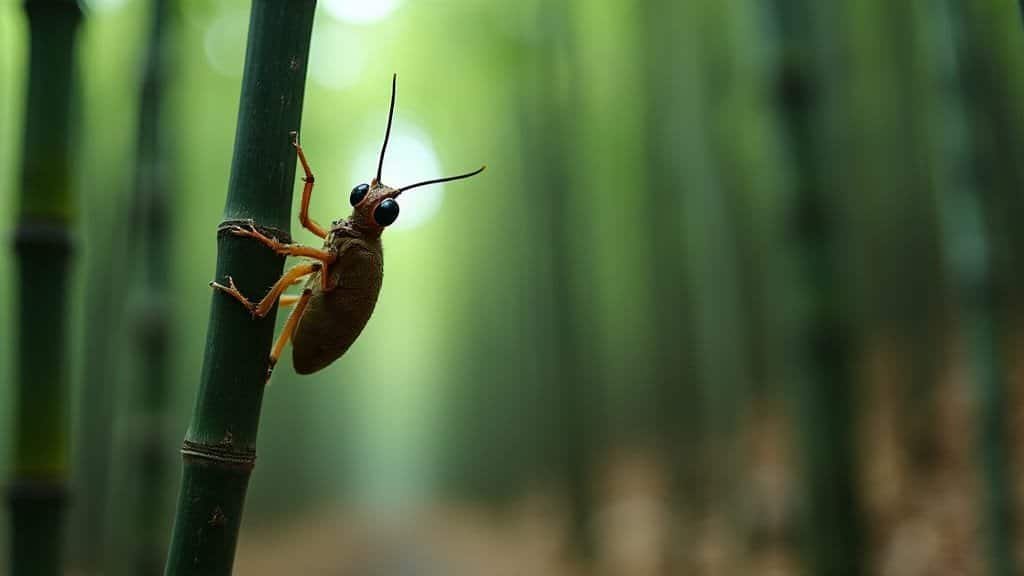Introduction
Understanding the impact of parasitic infections on wild red pandas offers critical insights into their health, behavior, and survival
Wild red pandas are exposed to various parasites in their natural habitats, which can lead to severe health consequences, including compromised immune function, changes in behavior, and even reduced lifespan
This article will delve into the types of parasites affecting red pandas, how these infections impact their health and reproduction, and the ways in which conservationists are working to mitigate these threats
Through this exploration, we uncover the key challenges and the efforts underway to protect these vulnerable animals from parasitic risks in the wild
Common Parasites Infecting Wild Red Pandas
Parasitic infections pose a serious threat to the health of wild red pandas. These small mammals, native to the forests of the Eastern Himalayas, are susceptible to various types of parasites that affect their immune health, energy levels, and overall survival
Some of these infections can lead to severe health consequences, especially in young or already weakened pandas. This section explores the common types of parasites found in red pandas, geographic differences in infection rates, and seasonal trends in parasite prevalence
Types of Parasites Observed in Red Pandas
Research has identified several types of parasites commonly infecting wild red pandas. The most frequently found parasites include gastrointestinal worms (e.g., Ascaris and Trichuris), as well as ectoparasites like ticks, fleas, and lice
In a study conducted by Sharma et al. (2021), gastrointestinal parasites were detected in nearly 40% of sampled wild red pandas in India and Nepal. These parasites disrupt the digestive system, leading to nutrient deficiencies, energy depletion, and weight loss
Protozoan parasites, such as Toxoplasma gondii and Cryptosporidium, have also been identified as significant threats. These microscopic organisms are capable of affecting a red panda’s nervous system, causing behavioral changes, lethargy, and sometimes fatal infections
According to Smith et al. (2020), protozoan infections are particularly concerning due to their potential to spread easily through contaminated water sources and food
Geographic Variation in Parasitic Infections
The distribution of parasitic infections in red panda populations is not uniform; it varies across geographic regions. A study by Kumar and Li (2021) found that red pandas in higher altitude areas of the Eastern Himalayas had lower instances of tick infestations than those in lower, warmer elevations
Lower elevations tend to host more insects and smaller vertebrates that can act as parasite carriers, increasing the risk for pandas inhabiting these areas
In the bamboo forests of Nepal, red pandas show higher rates of protozoan infections, likely due to water contamination and the presence of other animal species sharing the same ecosystem
Conversely, in the temperate forests of Bhutan, gastrointestinal worms are more common, possibly due to the red pandas’ dietary preferences and feeding behaviors in these regions
Seasonal Fluctuations in Parasite Levels
Seasonal changes also influence parasite prevalence among wild red pandas. Warmer months bring an increase in ticks and fleas, as warmer temperatures create ideal conditions for these parasites to thrive
During the summer, ticks are found to attach themselves to the skin, particularly around the ears and neck area of red pandas, which can lead to severe skin irritation and blood loss
Studies, including one by Wang et al. (2019), indicate that gastrointestinal parasites also show seasonal patterns, with higher rates of infection during rainy seasons due to increased contamination of food and water
Cold seasons, however, do not entirely eliminate the risk. Some gastrointestinal parasites form resilient cysts that survive in cold temperatures, continuing to infect red pandas that consume contaminated foliage or water sources
Impact of Parasitic Infection on Red Panda Health
Parasitic infections can severely impair red pandas’ health, affecting multiple aspects of their physiology and behavior. These infections compromise immune responses, induce nutritional deficiencies, and even shorten lifespan
Below, we explore how parasitic infections alter red panda health, including specific impacts on immune function, observable behavioral changes, and the broader implications for their survival
Effects on Immune Function and Physical Health
Parasitic infections place a constant strain on a red panda’s immune system. Research by Wang et al. (2019) showed that red pandas infected with gastrointestinal parasites, such as Ascaris and Trichuris, often experience a weakened immune response, making them more susceptible to secondary infections
Chronic infections deplete essential nutrients like iron, vitamin B12, and proteins, causing anemia, weight loss, and weakened musculature, all of which further compromise immune defenses
A healthy immune system is crucial for red pandas in the wild, as they regularly encounter pathogens from environmental sources. However, parasitic infections impair their ability to recover quickly, leaving them vulnerable to other threats, including bacterial and viral infections
Additionally, ectoparasites like ticks and fleas can transmit diseases as they feed on blood, further burdening red pandas with illnesses such as anaplasmosis, which affects blood cells and immune function
Behavioral Changes Due to Parasites
Parasites also bring about noticeable behavioral changes in infected red pandas, which are often responses to discomfort, pain, and energy deficits
These changes include reduced activity levels, decreased grooming behavior, and altered foraging habits. Infected pandas may avoid climbing, due to joint pain and muscular weakness, and display less exploratory behavior, remaining closer to their resting areas
According to Chen and Rong (2022), such behavioral changes not only reduce their ability to evade predators but also limit their access to food sources, intensifying malnutrition issues
Lethargy is another common symptom, especially in cases of high parasite load. Infected red pandas often spend more time resting than foraging, a behavior observed by Sharma et al. (2021) in a Himalayan study of infected and uninfected populations
As red pandas become more lethargic, their overall fitness declines, making it harder for them to maintain territory, seek out mates, and avoid predators
Consequences for Longevity and Survival Rates
Chronic parasitic infections can directly impact the longevity of red pandas. Studies suggest that persistent infections can reduce life expectancy by weakening physical health and intensifying vulnerability to predators
A comprehensive study by Kumar and Li (2021) found that red pandas infected with multiple parasite types had significantly shorter lifespans than their healthier counterparts
This reduced lifespan, combined with high mortality rates in young infected pandas, threatens the species’ population stability
Moreover, parasites indirectly affect survival rates by limiting the red pandas’ ability to reproduce successfully. Female red pandas burdened by parasitic infections often have lower reproductive success rates, which, coupled with infant mortality, poses a considerable challenge for population growth
Transmission of Parasites in Wild Red Panda Populations
Parasitic infections in red pandas spread through various transmission routes, with environmental factors and social behaviors playing a critical role
Wild red pandas are exposed to parasites through contaminated food, water, and direct contact with infected individuals. Understanding these pathways offers insights into managing and reducing infection rates
Main Transmission Pathways
The primary pathways for parasite transmission in red pandas are ingestion and direct contact
When red pandas consume contaminated foliage, bamboo, or water sources, they risk ingesting protozoan parasites like Toxoplasma gondii and Cryptosporidium. These parasites can survive in soil and water for extended periods, leading to widespread exposure
Fecal-oral transmission is particularly concerning, as red pandas often defecate near their foraging and resting areas
Studies, such as one by Sharma et al. (2021), show that red pandas frequently encounter their own fecal matter, which can carry intestinal worms like Ascaris. As red pandas return to these spots, they risk reinfection, creating a cycle of recurring exposure to parasites
Role of Habitat and Environmental Factors
Environmental conditions in red pandas’ natural habitats significantly impact the prevalence of parasitic infections. Dense bamboo forests, where red pandas primarily live, retain moisture and create humid conditions ideal for parasites, especially gastrointestinal and waterborne types
Seasonal rainfall exacerbates this issue by facilitating the spread of parasites through runoff, which contaminates feeding grounds and nearby water sources
Wang et al. (2019) observed that the rainy season consistently correlates with a higher incidence of parasite infections among red pandas due to these environmental factors
In addition, lower-altitude areas, which are warmer and more humid, have higher parasite densities than colder, high-altitude regions. Pandas in these regions are more likely to encounter and contract ectoparasites such as fleas and ticks
Chen and Rong (2022) suggest that red pandas living at lower elevations exhibit higher rates of infection due to the increased presence of these parasites
Impact of Social Behavior on Transmission Rates
Though red pandas are generally solitary, their limited social interactions can still contribute to parasite transmission. For instance, during mating seasons, close contact between individuals increases the likelihood of transferring ectoparasites such as lice or fleas
Female pandas, after giving birth, often come into close contact with their offspring, which may lead to parasite transmission from mother to cubs, especially if the mother is already infected
Another aspect of red panda social behavior influencing transmission is territory marking. Red pandas mark territory with scent glands, often near fecal deposits, leading others to come into contact with infected fecal matter
Studies, like the one conducted by Smith et al. (2020), highlight this behavior as a significant risk factor for the spread of gastrointestinal parasites in shared territories
Parasitic Infection Effects on Red Panda Reproduction
Parasitic infections impact not only the physical health of red pandas but also their reproductive capabilities. These infections can lead to reproductive health challenges, impact the survival and health of offspring, and contribute to population decline over time
Here, we examine how parasitic burdens affect red panda reproduction, the health of their young, and long-term consequences for population sustainability
Reproductive Health and Parasitic Burdens
Parasites have been shown to interfere with the reproductive systems of red pandas, particularly in females. Intestinal parasites, for instance, cause nutritional deficiencies that can disrupt hormone levels, reducing fertility and impacting the reproductive cycle
According to research by Kumar and Li (2021), female red pandas suffering from chronic parasitic infections have lower success rates during breeding seasons due to the toll infections take on their energy and nutritional reserves. This results in fewer successful pregnancies and a decreased number of healthy offspring
Additionally, infections with specific parasites, such as Toxoplasma gondii, can directly affect reproductive organs
In some cases, T. gondii infections lead to miscarriages or complications during pregnancy, as documented in studies on wildlife reproductive health (Chen & Rong, 2022). Such complications further reduce reproductive success and add to the overall challenge of population growth
Impact on Offspring Health and Survival
The health of red panda offspring is also closely tied to maternal health, which is compromised by parasitic infections. Cubs born to infected mothers may be more susceptible to infections themselves, due in part to the weakened health of the mother during pregnancy and nursing
Nutritional deficiencies resulting from parasites in the mother can lead to low birth weights and slower developmental growth in cubs
Research by Sharma et al. (2021) shows that red panda cubs from infected mothers are significantly less likely to survive the first year of life due to vulnerabilities stemming from parasitic exposure and the mother’s reduced ability to provide optimal care
Young pandas are particularly vulnerable to parasite exposure shortly after birth, as they begin to explore and interact with their environment. The damp and dense undergrowth typical of red panda habitats offers numerous opportunities for cubs to come into contact with parasite-laden soil or water
Moreover, because cubs often rely on their mother’s cues for foraging, if a mother is weakened by parasitic infection, her reduced mobility may also limit her ability to teach her young effective survival and foraging skills, further affecting cub health and development
Long-term Consequences for Population Growth
Over time, high rates of parasitic infection and its effects on reproduction pose a significant threat to red panda population stability. Reduced reproductive success among infected individuals limits population growth, especially given the already endangered status of red pandas
According to studies like those by Wang et al. (2019), repeated parasitic infections not only affect individual survival but also contribute to generational declines. If adult pandas are weakened or cannot produce healthy offspring, the population faces a compounded risk of decrease
As fewer healthy red pandas are born, the gene pool becomes more limited, and the species becomes increasingly vulnerable to disease, habitat loss, and other ecological pressures
Conservationists have highlighted the need for targeted interventions to address parasitic infections in breeding-age females to help improve reproductive outcomes and stabilize population numbers in wild habitats
Conservation Strategies to Mitigate Parasitic Threats
Given the impact of parasitic infections on the health, reproduction, and survival of wild red pandas, conservationists have implemented various strategies to mitigate these threats
Efforts focus on monitoring and treating infections, managing habitats to reduce exposure risks, and raising public awareness. These strategies are essential for supporting red panda populations and ensuring long-term survival
Monitoring and Treating Parasitic Infections
Regular monitoring of red panda populations for parasitic infections is a key conservation strategy. Health assessments help researchers detect infections early, allowing for timely intervention
Field researchers, as noted by Sharma et al. (2021), use fecal sample analysis to monitor intestinal parasites, providing data on infection rates and parasite types within different populations. These efforts have proven effective in detecting high-risk areas and specific parasite types impacting red pandas
In some cases, targeted treatments are administered, especially when red pandas are in protected environments like wildlife reserves. While treating wild red pandas directly is challenging, conservationists sometimes provide medical care to individuals under rehabilitation or those residing in semi-wild habitats
For instance, in areas like Sikkim, veterinarians at rescue centers occasionally administer antiparasitic medications to rehabilitated pandas before reintroducing them to the wild, thereby reducing the risk of spreading parasites upon release
Habitat Management to Reduce Parasite Risks
Managing the natural habitats of red pandas to minimize parasite exposure is another essential conservation strategy
Efforts include creating clean water sources and maintaining vegetation in ways that limit the spread of parasites. For example, clearing water sources of debris and avoiding overpopulation in limited areas can help reduce the contamination of food and water with parasite-laden feces, especially in high-traffic areas
Research by Chen and Rong (2022) highlights the benefits of habitat management in lowering infection rates among red panda populations. By reducing access to stagnant water sources and ensuring adequate space for each individual, habitat managers can reduce the conditions that lead to parasite proliferation
Additionally, habitat management practices that consider seasonal changes—such as providing clean water sources during rainy seasons—can further limit parasite transmission, particularly for waterborne parasites
Importance of Conservation Education
Raising awareness about the threats parasites pose to red pandas is essential for public support and effective conservation. Conservation organizations educate local communities and tourists about how human activity impacts red panda habitats and the spread of parasites
Programs such as those led by the Red Panda Network have been instrumental in promoting sustainable land-use practices among local communities, which in turn helps minimize human-induced contamination of red panda habitats
Educational initiatives also target behaviors that can reduce transmission risks, such as safe waste disposal, careful livestock management, and reducing deforestation, which can otherwise alter the natural ecosystem balance
Studies, such as those conducted by Wang et al. (2019), indicate that educated communities are more likely to adopt practices that protect red panda habitats, resulting in cleaner environments with fewer parasites
By focusing on these conservation strategies, efforts to reduce the impact of parasitic infections on red panda populations are becoming more effective
Through a combination of monitoring, habitat management, and education, these initiatives are paving the way toward a healthier and more resilient red panda population in the wild
Conclusion
Parasitic infections present a significant challenge to the health, reproduction, and long-term survival of wild red pandas. These infections affect red pandas in various ways, from compromising immune function and physical health to altering behavior and reducing reproductive success
Common parasites like gastrointestinal worms, protozoans, and ectoparasites spread through contaminated food, water, and habitat interactions, with seasonal and environmental factors influencing infection rates
Additionally, the consequences of these infections extend beyond individual health, impacting offspring survival rates and population stability over time
Conservation strategies have been developed to address these threats, focusing on regular monitoring of red panda populations, habitat management to minimize parasite exposure, and education initiatives to promote supportive practices among local communities
Efforts to provide medical care and antiparasitic treatment to at-risk red pandas, especially in semi-wild environments or rehabilitation centers, further enhance survival chances
Through these collective conservation actions, scientists and wildlife advocates aim to protect and stabilize red panda populations, ensuring their continued existence within their natural habitats





